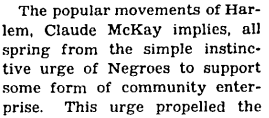Context
Overview
McKay was born in 1889 in Clarendon Parish, Jamaica. At 17 McKay moved to Kingston, Jamaica but he experienced extreme racism there and shortly returned home to Clarendon Parish. He won a prize for his book "Songs of Jamaica" and used the prize money to move to the United States. After moving around the U.S. he decided to stay in Harlem, New York.
Historical Context
The Great Migration was the movement of nearly one million African Americans from the South to the North, as they were threatened with lynchings and persecuted by a series of racist laws called Jim Crow. New York City was a popular place for black people to live, tenements were filling up and the city was very crowded. This allowed the Harlem Renaissance, the time when black artists found a need for community, to begin.
"The cultural outburst, which followed the dramatic influx of Southern blacks into Northern cities during and after the war (the so-called Great Migration), brought the debate over racial identity and the future of black America to the forefront of the national consciousness."
- Chris Bodenner in The Blossoming of African American Culture in the 1920s

Roi Ottley "Claude McKay's Picture of Harlem" - The New York Times Nov. 24, 1940.
Political Climate
The Harlem Renaissance started at the end of World War I. As hate crimes and acts of prejudice were seen on a daily basis, racism and bigotry was intolerable for black people. Communism was popular among African Americans because it offered a promise of equality, one that the U.S. was not focused on. McKay and many other black artists supported the ideas of Communism until 1945 when McKay traveled to Moscow and realized that Russia didn't believe in equality like he previously thought.
"The instigating event, for him [McKay], was Soviet Russia’s failure to cease trade with Italy even after Mussolini had invaded Ethiopia." - Jennifer Wilson, New York Times.

Soviet Flag - McKay traveled to Russia in 1945